Kirgistan |
|
|
|
| Übersicht – Contents: | |
Diese Seite ist Teil des Projektes
Kirgistan |
|
|
|
| Übersicht – Contents: | |
Flaggen – Flags: |
|
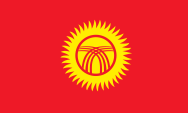 |
Nationalflagge – national flag, Seitenverhältnis – ratio = 3:5, Quelle/Source, nach/by: Wikipedia (D)   |
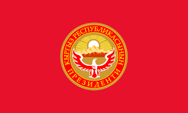 |
Präsidentenflagge – flag of the President, Seitenverhältnis – ratio = 3:5, Quelle/Source: Jeff Dahl, wikipedia [Public domain], via Wikimedia Commons |
historische Flaggen – historical Flags: |
|
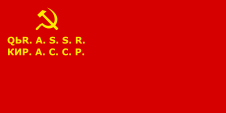 |
1929–1936, Flagge der Kirgisischen Sozialistischen Sowjetrepublik – flag of the Kyrgyz Socialistic Soviet Republic, Seitenverhältnis – ratio = 1:2, Quelle/Source: Wikipedia (EN), Own work, Public domain, via Wikimedia Commons |
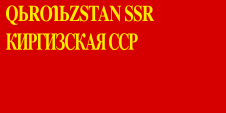 |
1936–1940, Flagge der Kirgisischen Sozialistischen Sowjetrepublik – flag of the Kyrgyz Socialistic Soviet Republic, Seitenverhältnis – ratio = 1:2, Quelle: Wikipedia (EN), Phil Chekhov, CC BY-SA 4.0, via Wikimedia Commons |
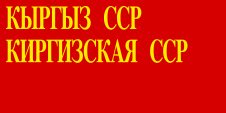 |
1940–1952, |
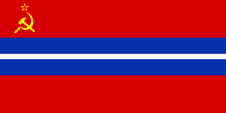 |
22.12.1952–03.03.1992, |
|
siehe auch – look also: Flaggengeschichte der Sowjetrepubliken der UdSSR – flag history of the soviet republics of the USSR |
|
|
|
|
Bedeutung/Ursprung der Flagge – Meaning/Origin of the Flag: |
|
| Die heutige Flagge Kirgistans wurde am 03.03.1992 eingeführt. Sie zeigt in der Mitte eines roten Flaggentuches eine goldene Sonne mit vierzig Strahlen, in der das Dach einer Jurte – ein sogenannter Tjundjuk – abgebildet ist. Die Sonne steht den heißen Sommer in der kirgisischen Steppe. Das Dach der Jurte steht für Gastfreundschaft und Ehrlichkeit, und soll auch an das nomadische Hirtenleben der ländlichen Bevölkerung in den vergangenen Jahrhunderten erinnern. Die beiden Farben der Flagge, das Rot und das Gelb werden mit Pantone 1788 und 100% Yellow angegeben. | The
today's flag of Kyrgyzstan was introduced on 3rd of March in 1992. It shows
in the middle of a red bunting a golden sun with forty points, in which is
depicted the roof of a native round tent – a so named Tjundjuk. The sun symbolizes the warm summers in the Kyrgyz steppe. The roof of a native round tent stands for hospitality and honesty, and should also remember the nomad herdsman live of the rural population in the gone centuries. The two colors of the flag, the red and the yellow, are specified with Pantone 1788 and 100% yellow. |
| Quelle/Source: Nationalflaggen der Welt, Flaggen-Atlas Erde, Wikipedia (EN) | |
Wappen – Coat of Arms: |
|
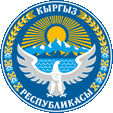 |
seit/since 1994, Wappen Kirgistans – coat of arms of Kyrgyzstan, Quelle/Source: А. Абдраев (A. Abdraev), С. Дубанаев (S. Dubanaev) 1994. Standardized version:Nurbek Nasyranbekov Nargiza Kulataeva, Kanat Karapashov, Marcel Sheishenov(2016). [Public domain], via Wikimedia Commons |
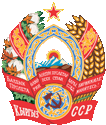 |
1956–1994, Wappen der Kirgisischen Sozialistischen Sowjetrepublik – coat of arms of the Kyrgyz Socialistic Soviet Republic Quelle/Source: TheSign 1998 [Public domain], via Wikimedia Commons |
Bedeutung/Ursprung des Wappens – Meaning/Origin of the Coat of Arms: |
|
| Das heutige Staatswappen wurde am 14.01.1994 eingeführt. Es ist eine einfarbige blaue Scheibe, die im Vordergrund einen silbernen Falken mit ausgebreiteten Schwingen zeigt. Im Hintergrund ein See und der Hinteralaiische Gebirgsrücken (Ille Ala Toosu) mit der höchsten Erhebung des Landes, dem Pik Lenin (7 134 m). Dahinter eine strahlende, aufgehende, goldene Sonne. Das Ganze ist umgeben von Weizenähren und Baumwollblüten, sowie dem Namen des Staates in kyrillischer Schrift. | The
today's coat of arms of the state was introduced on 14th of January in 1994.
It is a single-coloured blue disk, which shows in the foreground a silvery
hawk with outspread wings. In the background a lake and the Back Alaijan
Range (Ille Ala Toosu) with the highest mountain of the country, the Pik
Lenin (7.134 m). Behind a glowing, rising, golden sun. All this is surrounded by wheat ears and cotton blossoms, as well as the name of the state in cyrillic fonts. |
| Quelle/Source: Nationalflaggen der Welt, Flaggen und Wappen der Welt | |
Flugzeugkokarde – aircraft roundel: |
|
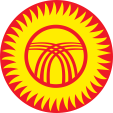 |
Flugzeugkokarde – aircraft roundel Quelle/Source, nach/by: Wikipedia (EN) |
Landkarten – Maps: |
Lage – Position: |
Landkarte des Landes – Map of the Country: |
Zahlen und Fakten – Numbers and Facts: |
|
|
|
|
|
|
|
|
|
|
|
|
|
|
|
|
|
|
|
|
|
|
Geschichte: |
| ca. 840 ·
Ansiedlung der Kirgisen im Reich der Uiguren 10. Jhd. · Herrschaft der Karachaniden 1219 · Eroberung und Beginn der Herrschaft durch die Mongolen unter Dschingis Khan 1227–1280 · das Gebiet des heutigen Kirgistans gehört zum Reich des Tschagatai, eines Sohnes des Dschingis Khan 14. Jhd. · mit dem Verfall der Mongolenreiche bildet sich in der Region das Khanat Mogolistan, später zum Reich Kaschgarien 18. Jhd. · das Gebiet gehört zu China 1830 · das Gebiet kommt zum zum Khanat Kokand 1850–1876 · Russland unterwirft die Kirgisen 1862 · Gründung von Pischpek als russische Kolonistenstadt 1865 · Bildung des Generalgouvernements Turkestan, damit Anschluss an Russland 1918 · Errichtung der Sowjetdiktatur, Gründung der Turkestanischen Autonomen Sozialistischen Sowjetrepublik (innerhalb Sowjetrusslands – Russische Sozialistische Föderative Sowjetrepublik) auf dem Gebiet der heutigen Staaten Turkmenistan, Usbekistan, Tadschikistan und Kirgistan Oktober 1924 · Auflösung der Turkestanischen Autonomen Sozialistischen Sowjetrepublik, Bildung des Karakirgisischen Autonomen Bezirks (Autonome Oblast), innerhalb Sowjetrusslands 25.05.1925 · Umbenennung in Kirgisischer Autonomer Bezirk (Autonome Oblast) 01.02.1926 · Gründung der Kirgisischen Autonomen Sozialistischen Sowjetrepublik (innerhalb Sowjetrusslands), Umbennung von Pischpek in Frunse 1935 · Erhebung zur Kirgisischen Sozialistischen Sowjetrepublik (als Teil der Sowjetunion) 31.08.1991 · Unabhängigkeit, Umbenennung von Frunse in Bischkek 1993 · Neue Verfassung 2010 · bewaffnete Auseinandersetzungen zwischen Kirgisen und Usbeken 2010 · umsturtzartiger Regierungswechsel, neue Verfassung 2021 · die Veränderungen der Verfassung von 2010 werden rückgängig gemacht |
History: |
| ca. 840 ·
settle of the Kyrgyzians in the Empire of the Uyghurs 10th cent. · rule of the Karakhanides 1219 · conquered and begin of the rule by the Mongols under Dshingis Khan 1227–1280 · the region of the today's Kazakhstan belongs to the Empire of the Tshagatai, son of Dshingis Khan 14th cent. · with the decay of the Mongolian empires comes into being in the region of the today's Kyrghyztan the Khanate of Mogolistan, later to the Kashgarian Empire 18th cent. · the region belongs to China 1830 · the region comes to the Khanate of Kokand 1850–1876 · Russia submits the Kyrgyzians 1862 · foundation of Pishpek as a Russian colonist city 1865 · formation of the General Government of Turkestan, in this way annexion to Russia 1918 · establishment of the Soviet Dictatorship, foundation of the Turkestanian Autonomous Socialistic Soviet Republic (within Soviet Russia – Russian Socialistic Federative Soviet Republic) on the territory of the today's states Turkmenistan, Uzbekistan, Tajikistan and Kyrgyzstan October 1924 · dissolution of the Turkestanian Autonomous Socialistic Soviet Republic, formation of the Kara-Kyrgyz Autonomous District (Autonomous Oblast), within Soviet Russia 25th of May 1925 · rename in Kyrgyz Autonomous District (Autonomous Oblast) 1st of February 1926 · foundation of the Kyrgyz Autonomous Socialistic Soviet Republic (within Soviet Russia), rename of Pishpek in Frunse 1935 · elevation to the Kyrgyz Socialistic Soviet Republic (as part of the Soviet Union) 31st of August 1991 · independence, rename of Frunse in Bishkek 1993 · new constitution 2010 · armed fights between Kyrgyzians and Uzbeks 2010 · tumultuous change of government, new constitution 2021 · the amendments to the 2010 constitution are reversed |
| Quelle/Source: Atlas zur Geschichte, World Statesmen, Die Völker der Erde, Wikipedia (D) |
Ursprung des Landesnamens – Origin of the Country's Name: |
|
| Der Name des Landes geht auf die hier lebenden Kirgisen zurück, die der Überzeugung sind, dass der Name ihres Volkes von dem Wort "kirkkyz" abstammt, was "vierzig" heißt, und sie somit die Nachfahren von 40 Stämmen seien. | The name of the country goes back to the Kyrgyz nation, which is living here. The Kyrgyz are convinced that the name of their people comes from the word "kirkkyz", which means "forty", and thus they are the descendants of 40 tribes. |
| Quelle/Source: Wikipedia (D) | |